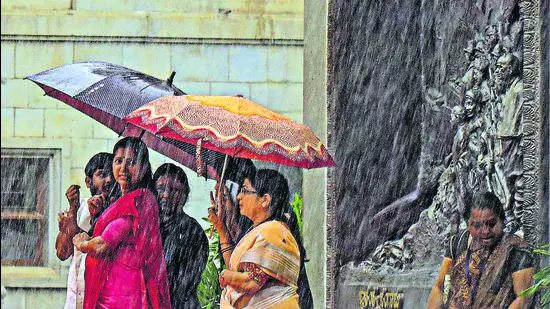Bengaluru, India’s tech capital, is grappling with a deluge of unprecedented proportions as heavy pre-monsoon rains have brought the city to a standstill. The India Meteorological Department (IMD) issued a red alert for Bengaluru and coastal Karnataka on Tuesday, forecasting extremely heavy rainfall exceeding 20.4 cm, following a record-breaking 105.5 mm of rain in the 24 hours ending 8:30 AM on May 19. The downpour, described as the heaviest May rainfall since 2022, has unleashed widespread flooding, traffic gridlock, and civic chaos, exposing the city’s crumbling infrastructure and raising urgent questions about its preparedness for intensifying climate challenges.
The rains, which began pounding Bengaluru on Sunday night, transformed major roads into rivers and low-lying neighborhoods into lakes. Areas like Rajarajeshwari Nagar, which recorded a staggering 132 mm of rain, bore the brunt, with homes inundated and residents wading through knee-deep water. “My furniture is ruined, and we’ve had no power since midnight,” said Priya Menon, a resident of HSR Layout, one of the worst-hit zones alongside Silk Board, Koramangala, and Sai Layout. The city deployed dinghies and tractor trailers to rescue stranded families, evoking scenes typically associated with monsoon-season calamities, despite the southwest monsoon’s official onset still weeks away.
The IMD attributes the extreme weather to an upper-air cyclonic circulation over the Southeast Bay of Bengal, pulling moisture across southern India. Bengaluru’s forecast for Tuesday predicts partly cloudy skies with heavy rain and thunderstorms, with gusty winds of 30-40 kmph. Temperatures are expected to hover between 20°C and 30°C, offering little respite from the humidity. While the intensity may subside in southern Karnataka by Wednesday, northern districts face an orange alert—indicating 11-20 cm of rain—through Thursday. Coastal Karnataka, including Dakshina Kannada and Udupi, is under a red alert until May 21, with fishermen warned to avoid sea ventures due to squally winds reaching 55 kmph.
The human toll is mounting. At least five rain-related deaths have been reported across Karnataka, including one in Bengaluru, where a commuter was swept away in floodwaters near Nagawara. Hospitals are seeing a surge in injuries from slippery roads, and schools have shifted to online classes. “My kids haven’t left home in two days,” said Anil Sharma, a tech worker in Whitefield. The city’s IT sector, a cornerstone of Bengaluru’s economy, is reeling, with companies like Infosys urged by BJP MP PC Mohan to implement work-from-home policies through Wednesday to ease commuting woes.
Traffic disruptions have paralyzed Bengaluru, with key junctions like Hebbal, Sarjapur, and Yelahanka Circle submerged. The Bengaluru City Police issued advisories warning of delays on New BEL Road and Allalasandra, urging commuters to avoid flood-prone underpasses like Tindlu. Flight delays at Kempegowda International Airport compounded the chaos, stranding travelers. Local businesses, from roadside eateries to tech startups, report losses as foot traffic dwindles. “My café hasn’t had a customer since Sunday,” said Meera Rao, a Koramangala shop owner.
Chief Minister Siddaramaiah, who inspected flood-hit areas from the Bruhat Bengaluru Mahanagara Palike (BBMP) war room, acknowledged the crisis’s severity, noting that 104 mm of rain on Sunday exceeded expectations. He announced emergency measures, including silt removal from storm-water drains and remodeling clogged channels. Deputy Chief Minister DK Shivakumar, overseeing relief efforts, promised “long-term solutions” to address drainage issues neglected across administrations. “We’re working round-the-clock,” he said, visiting waterlogged Sai Layout, where homes were submerged under two feet of water.
Yet, these assurances ring hollow for many residents, who point to chronic civic neglect. Bengaluru’s storm-water drains, plagued by encroachments and poor maintenance, are ill-equipped for heavy rains. Of 4,292 identified encroachments, only 2,326 have been cleared, leaving low-lying areas vulnerable. Urban sprawl, with concrete replacing green spaces, has reduced the city’s ability to absorb water, exacerbating floods. “This isn’t just rain; it’s a failure of planning,” said urban planner Vinod Kumar, noting that Bengaluru’s drainage system, designed for 50 mm of rain, buckles under triple that amount.
The crisis has sparked a political firestorm. The opposition BJP and Janata Dal (Secular) slammed the Congress-led government for inaction, with BJP leader Amit Malviya accusing Siddaramaiah and Shivakumar of treating Bengaluru as “an ATM” for political gains. Congress leaders countered that infrastructure woes stem from decades of mismanagement across parties. Residents, caught in the crossfire, express frustration. “Every year, it’s the same story—promises but no action,” said Rajesh Gupta, a flooded-out resident of Manyata Tech Park.
The rains’ timing, ahead of the IPL’s resumption, adds another layer of disruption. The Royal Challengers Bengaluru (RCB) vs. Kolkata Knight Riders (KKR) match scheduled for May 21 at Chinnaswamy Stadium faces uncertainty, with forecasts predicting a 71% chance of rain during the toss. While the stadium’s advanced drainage system offers hope, the city’s broader mobility challenges could dampen fan turnout.
Beyond immediate impacts, the deluge underscores Bengaluru’s vulnerability to shifting weather patterns. Meteorologists warn that climate change is intensifying pre-monsoon rains, with May 2025’s 105.5 mm deluge surpassing the previous May record of 2022. The IMD’s C.S. Patil noted that the southwest monsoon may arrive early by late May, potentially prolonging wet conditions. Experts like Dr. Anjali Rao argue that Bengaluru’s urban heat island effect, driven by deforestation and concretization, amplifies rainfall intensity. “We’re seeing monsoon-like rains in May because the city’s ecosystem is out of balance,” she said.
Long-term solutions remain elusive. Proposals for sponge cities—urban designs that absorb rainwater through green spaces—have gained traction but face funding hurdles. The BBMP’s budget for drain upgrades, slashed by 15% in 2024, limits progress. Community groups are stepping in, with volunteers in Koramangala clearing debris from drains, but such efforts are stopgaps. “We need systemic change, not band-aids,” said activist Priya Desai, who runs a local flood-relief NGO.
As Bengaluru braces for more rain, residents are adapting. Families stockpile essentials, commuters reroute travel, and businesses shift online. Yet, the city’s spirit remains resilient. “We’ll get through this, but the government must act,” said Sharma, echoing a common sentiment. Nuzpost will track this unfolding crisis, exploring its impacts on Bengaluru’s people, economy, and future.

